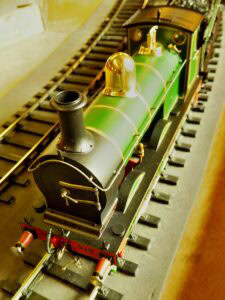21st September at Badlesmere Ross S
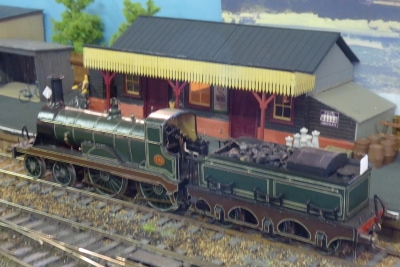
We arrived to find various maintenance tasks in progress at the hall, including painting of the corrugated roof. Jim and John B quickly took up residence at the modelling tables. Jim brought his superb engine shed, while John B, having completed a six-wheeled milk tank (apart from painting and transfers), was seen studying the instructions for a Slater’s 4-wheel carriage. He announced that the finished model would be fully detailed. We have no doubt on that score. David Ho, in between his much appreciated catering duties, was tackling the backscene for Sarre which had suffered some creasing. It needs to be rolled up very carefully.
Richard B turned up with some exquisite scratch-built models which he put through their paces on Sarre, due to be exhibited at the Gravesend show over the first weekend in November. First up was a lovely model of an unusual prototype, LB&SC petrol railcar No.4. David G was soon drooling over the curvaceous and be-rivetted underframe. Other locos from Richard’s stable were all elegant 4-4-0s; a lined black LCDR ‘M’ class, an SER ‘F’ class ‘Onward’ (named for the Paris Exhibition of1889) and depicted in its umber livery; and, finally, a beautifully finished SER ‘A’ class. They were all run through most, if not all, of the tracks on Sarre, which was a useful exercise, not only for Richard, but also for Sarre. All too soon it was time to pack up, whereupon David G and I realised that neither us had made any progress on our current modelling tasks.
18th September at Badlesmere Rob M – photo Ross S
A huddle quickly developed thanks to Ross spreading a selection of donated scenic and modelling items on the Sales Table. Many present found pieces of potential use to them, with the profits swelling group funds.
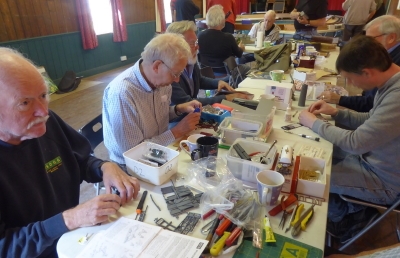
Sixteen of us turned up on a sunny, if breezy, day; soon having the Circuit out for test running alongside the modelling tables. Wagons featured today; with vans, opens and a six-wheel tanker being worked on and practical advice given. An LNER 0-6-0, carriages, a long van and a small rustic station occupied another corner. John J brought a lighthouse to construct, while David G was setting up a riveting machine. A GWR Prairie with a mixed train and an Austerity tank with a miners’ train were first on the tracks; Barry W and others following. Magazines and books were shown or passed one, as we found out who had flown in a Rapide, or knew about Bristol 170s, before returning to railways. David Ho. was preparing a backscene for Sarre and keeping an eye on the kitchen, where others lent a hand.
4th September at Badlesmere Ross S

Nineteen of us gathered on a wet morning. Once in we saw a hive of activity. The Circuit was being erected. Paul H was firing up a chip checker – nothing to do with fish apparently. Jim H, not content with just a few ships, had a complete harbour this time. John B was drilling a hole in another tanker. Roger had a saucer of water ready for some transfers. Paul W was building two S&D ground signals to replace the SR standard ones at Edington. I joined the workers on the modelling tables, starting to build an ex-LSWR brake van as used on the KESR and EKR (and the Isle of Wight). It’s a mixed-media kit, white metal and plywood. Barry W punctured my self-confidence by asking if the plywood planking matched the bolt heads on the white metal frames. “Nearly” was the unsatisfactory reply. Geoff pulled in with a L&YR Pug and brake van. He then placed alongside them a lovely, shiny Oxford models Austin 7. Later he and Paul H called our attention to the financial situation of the Guild. They asked members if they would countenance paying another £10 a year to keep the Guild afloat and ensure the continuation of the high standard of the Gazette. The general feeling was, I think, positive.
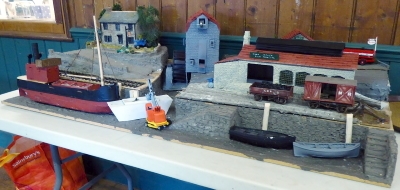
Spotted on the Circuit today were Barry W’s BR(S) ‘C’ class 0-6-0 no.31256, John P’s SR M7 no.676 in striking malachite livery, and David G’s nicely weathered ex-S&D 2P no.40700 with two lovely coaches in BR carmine. There was also a BR ‘Gronk’ 3828 in green circling around with three tankers and a brake van. I added my, as yet un-numbered and un-named, black Hudswell Clarke 0-6-0T to the roster, coupling it up to a train consisting of both the red coaches and the tankers and brake van. Despite scepticism about its ability, it romped – well trundled – away with it. Later Colin brought out his electro diesel which initially slipped, but once on the move it found its feet. “Just like the real thing!” remarked Colin.
David Ho back from a holiday break efficiently provided both morning refreshments and tea and coffee to go with our packed lunches. David and his helpers (the usual suspects) earned our appreciation, but before long it was time to pack up and head home into a dry but blustery afternoon.
News from Garth, our member in Australia
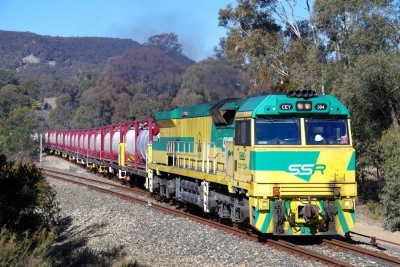
I’ve finished the glazing on the Janick Midland brakecoach and the seats are in place. I’m pleased with my latest wagon, a Bachmann Brassworks 20ton tanker. Luckily I found it is not a varnished model so it’s ready for primer. We’ve been having a cold spell recently with some snow and high winds. The country is still in drought with water restrictions in place. Many of the towns are running out water. I thought this photo might be of interest – This is one of theSouthern Shorthaul Railroad (SSR) locos carting water to one of the mines out past Lithgow. Thirty wagons on this train. It will offload the water into the mine’s storage dam.
Stop Press from Guildex Telford: Mike Perry takes Best in Show for Landscapes – His splendid viaduct (Photo at EKOGG by Ross)
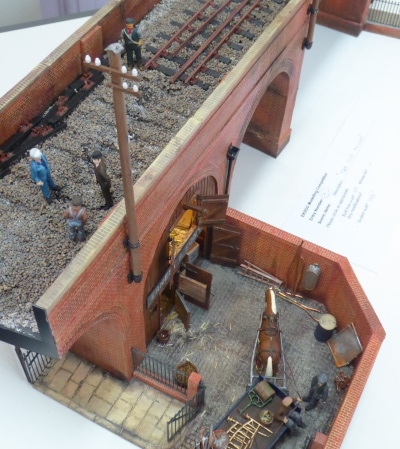
21st August Badlesmere David G
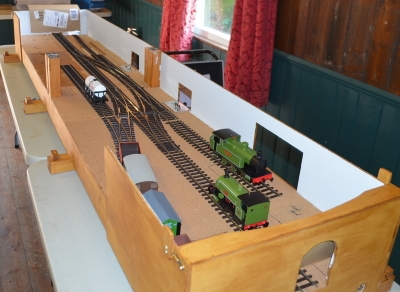
Jack brought his current layout, an 8’ by 1’3” shunting yard, along with some stock and locos to run on it. Its DCC, so interested members, along with the use of Setrack points which allow maximum space for sidings, being only 3’4” radius, which did not interfere with the industrial locos
Several members brought brake vans and twelve of them paraded around the circuit, hauled at a snail’s pace by the Sentinel, and then at more spirited pace behind Barry W’s G and Wclass tanks. Jim P’s mighty Merchant Navy made a magnificent authentic Bulleid sound even though the rake of Pullmans remained unused this time.
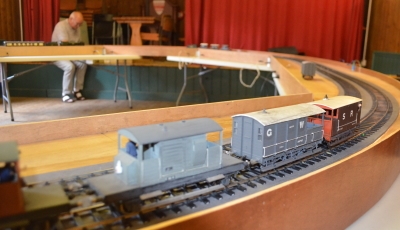
At the work tables, John B progressed his 6-wheel milk tank chassis, John H conjured up an atmospheric village garage, while Richard added more to his LBSCR railcar – an unusual but splendid period piece. Paul tackled Stevens flap signals for Edington, to replace the present ground signals which are too modern.
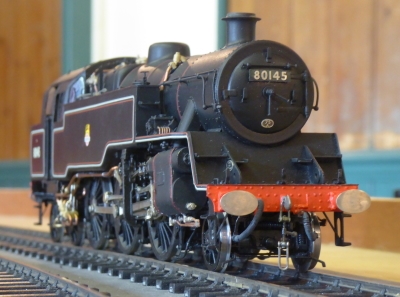
17th August Badlesmere Ross S
Ten of us today; as Roger remarked, just enough. Half of us had lunch at the Red Lion, the rest hung about a bit to await the unlocking of the hall. Once in we soon set up the tables and the Circuit. Edington was given a rest after its successful outing to Bexhill. John P nobly provided us with tea and coffee. He had some help from others including Chris N. We were all very grateful
Part of Sarre was put out in order to try the photographic backscene using Velcro and double-sided sticky tape. There was a startling difference between the section where the backscene was placed and that which still had the plain backing. The Velcro needs a stronger fixing method, however.
On the Circuit Barry gave his beautifully built Riddles 2-6-4T 80154 (now painted and fully lined out) an extended run, while Jim was running-in his brand new Dapol NCB (ex GWR) Pannier 7754. Painted a pale green, it has a removable cab roof, showing off a well detailed interior. The roof is fixed in place by two small magnets making it easy to place the crew. Jim ran it for half an hour one way, then half an hour the other, in accordance with the manufacturer’s recommendations. All was well.
We decided to illuminate the modelling tables with one set of the spotlights from the layouts. It made detailed work so much easier. John B, having finished his 4-wheel petrol tank, was tackling a Slater’s 6-wheel milk tank. This has an ingenious method of incorporating the sprung coupling hooks needed because of the open framework – tricky. Chris N was painting some plastic figures for David G’s charabanc. As the group’s resident gadget-man, he inveigled me into using a battery tool to improve the figures he was working on. The idea was the remove flash and mould lines. It was much easier than using files or bits of sandpaper. Chris also brought along a ‘wet palette’ which enabled him to continue painting through the afternoon without needing water. Roger was building a BR standard box van from a kit for a grounded body by adding the running gear. Meanwhile David G was fettling the resin body of a single plank wagon prior to installing the etched components for the underframe which he managed to do before the end.
All was neatly packed away well before the official close of play. But not before David G had inveigled me and Fred into providing an illustrated session in the winter programme at the Fleur on the Isle of Wight railways.
7th August Badlesmere Ross S
Nineteen of us gathered for a meeting of contrasting interests. By the time I arrived, Edington Junction and The Circuit were in position. The prime task there was to fettle the layout in readiness for the Bexhill exhibition on Saturday. Soldering iron, track cleaning equipment were deployed, by Chris M, David G, Paul W and David Ho, while a 4F was used to test the track by running to and fro on every inch of track, including, of course, that on the traversers. It was a bit like a 7mm version of a Branch Line Society outing. No buffer stops, I understand, were threatened by the loco. The fault that occurred during the Friends and Family open day was reported to have been caused one dry joint. Once that was fixed, it was ‘job done’.
First out on The Circuit was Barry W’s superb BR 2-6-4T. Next was Fred’s LMS early diesel shunter with jack shaft drive. It pulled a short train of GWR vehicles including a bogie bolster wagon built from an old, mainly wood, kit. Its load was heavy metal girders which, Fred said, made the loco slip slightly (but I couldn’t detect it). It’s always a pleasure to see what Colin S is going to bring to run. This time it was a BR(S) 4CEP EMU as used on the Victoria – Dover/Ramsgate services. It was immediately recognisable in its blue/grey livery. Colin often uses The Circuit as a test track. This time was identified problem: two of the coaches would not couple together. The coach with the motor bogie was riding too high; the Kadee couplers could not engage. One of the locos on the other track was John B’s Sentinel 0-4-0 VBT, obtained recently at Roger H’s sales stand. It circled around with no problem.
A startling sight to some of us on the modelling tables were three boats, including what seemed an enormous Clyde Puffer as once seen at Chatham. I was assured by John H that it was the correct size as he continued working on the bridge. Meanwhile Jim P was starting to build a Slater’s kit for a SR Maunsell bogie carriage. Why do the floor pan sides and roof come in two halves, he wondered. At the other end of the tables, John B continued building his oil tank wagon which is looking very promising. Stuart breezed in with, amongst other things, a fault finding chart for railcars. As the proud owner of a model AC Cars railbus he gave it to me!
Tim arrived with the sheet of ply that will form the base of the planned working diorama. Deep discussions ensued about the optimum track plan. It was eventually settled for this week at least, without the need for Templot. Several of us promised to bring templates or even actual points to help finalise the plans.
Too soon, it was time to pack up, wish our Edington colleagues good luck, thank David Ho and helpers who provided tea and coffee. Buzzards wheeled overhead as we left.
STOP PRESS: “We had a good day at Bexhill and received lots of welcoming and positive comments”, David G & the Team at the Bexhill show with our Edington Junction layout. Sat. Aug 10th



